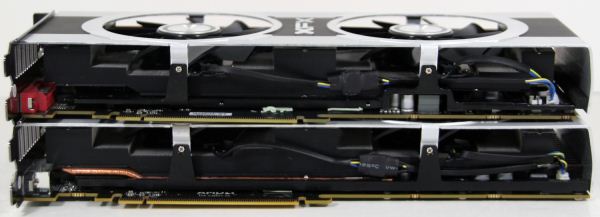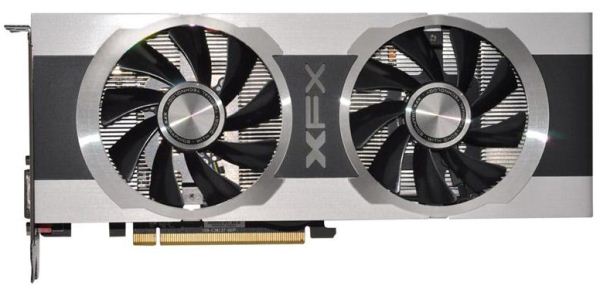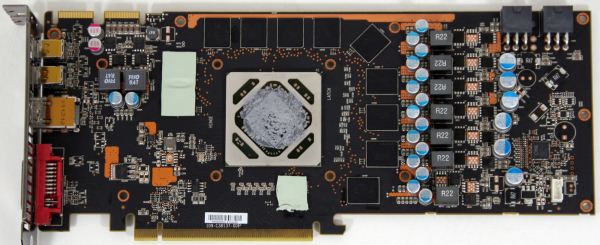AMD Radeon HD 7950 Review Feat. Sapphire & XFX: Sewing Up The High-End Market
by Ryan Smith on January 31, 2012 9:02 AM ESTMeet the XFX R7950 Black Edition Double Dissipation
Our second partner card of the day is XFX’s R7950 Black Edition Double Dissipation. Like the 7970 Black Edition Double Dissipation we reviewed earlier this month, the 7950 BEDD is a factory overclocked card (Black Edition) using XFX’s Double Dissipation cooler.
Starting with the overclock, XFX is shipping the 7950 BEDD with a core clock of 900MHz and a memory clock of 5.5GHz. This represents a 100MHz (12.5%) core clock overclock and 500MHz (10%) memory clock overclock, putting it just shy of the 925MHz core clock the 7970 ships at.
In terms of construction like all of the other 7950 cards launching today XFX is using AMD’s 7950 PCB. This means the PCB measures 10.25” long and features 2 6pin PCIe power sockets towards the rear of the card, while at the front the card uses the AMD standard port configuration of 1 DL-DVI, 1 HDMi, and 2 mini-DisplayPorts. The one notable deviation here from the Sapphire card is that XFX has not included a BIOS selection switch, so the card lacks any kind of ability to easily recover from a bad BIOS flash, and if unlocking proves viable it would not be a good candidate for the process.
Meanwhile cooling is provided by XFX’s Double Dissipation cooler. This is the same heatsink and fan assembly we saw with the 7970 BEDD, which makes this an open air cooler using a pair of fans to push air along an aluminum heatsink running almost the entire length of the card. Because it’s the same assembly, the shrouding for the card sticks out over the end of the PCB, negating the benefit of the shorter 7950 PCB and making the card 10.65” long just like the 7970 BEDD.

Top: 7950 BEDD. Bottom: 7970 BEDD
Do note that while it uses the same fan and heatsink assembly, Double Dissipation does not mean it uses the same vapor chamber assembly to transfer heat from the card. Where the 7970 BEDD used a fairly large vapor chamber, the 7950 BEDD uses a much smaller vapor chamber that only makes contact with roughly half of the heatsink, meaning that heat isn’t being transferred to the extremities of the heatsink nearly as well on the 7950 BEDD. Furthermore the aluminum plate covering the RAM and MOSFETs is poorly sized, leaving parts of the RAM chips (and their thermal pads) exposed. We’ll see how this plays out when we get to our testing, but the 7950 BEDD is clearly not as well built as the 7970 BEDD.
Rounding out the package is the same collection of extras that we saw in the 7970 BEDD. Inside you’ll find the usual driver CD and quick start guide, along with a metal XFX case badge, a mid-length CrossFire bridge, and a passive HDMI to SL-DVI adaptor. All of this is packed in one of XFX’s pleasantly small boxes, which doesn’t use much more space than the card itself.
The MSRP on the 7950 BEDD is $499, $50 over the MSRP for a regular 7950 and making it one of the more expensive 7950s launching today. XFX is offering a base 2 year warranty on the 7950 BEDD, which can be extended to a lifetime warranty by registering the card within 30 days of purchasing it.












259 Comments
View All Comments
mak360 - Tuesday, January 31, 2012 - link
i would easily buy the HD7950 over the old tech - outdated - hot - power hungry - loud GTX580 junk. The HD7950 is same price, new tech, uses 72 watts less, is cooler, is silent, is 28nm, is faster, has compute, has pcie3, has x3 monitors, has audio over each channel, also slaps the 590 if thats what you want lol.its a win-win, you would have to be an idiot to buy anything nvidia has currently in the high end.
chizow - Wednesday, February 1, 2012 - link
Anyone interested in high-end already owns Nvidia and is hitting the snooze button on this launch until Kepler.There's only a 15-25% reason to buy a 7970, 0-5% reason to buy a 7950.
Death666Angel - Wednesday, February 1, 2012 - link
You keep repeating it, and you keep being wrong. There are a million reasons for someone to upgrade their system now. Maybe they got a better monitor for christmas and need the graphics card upgrade but waited a month until AMD revealed their new tech? Maybe it's someones birthday and he can get a big card. Or someone got a new job and wants a new card today? Not everyone who has the money and need for such a card now had it in the months before it.chizow - Wednesday, February 1, 2012 - link
In that case, they should probably wait for the real next-gen, since that's what most anyone was doing prior to the disappointing Tahiti reveal.Or go ahead and pick up a 6970/570 for much better price/performance return. Although we may actually see the prices go back up now that its obvious Tahiti did nothing to force downward pricing pressure.
yankeeDDL - Wednesday, February 1, 2012 - link
Just look at the review from Tomshardware.Based on performance, they were expecting the 7950 to be prices around $480. Then they were informed about the MSRP of $450 and took it extremely well.
Just sayin'
Spunjji - Wednesday, February 1, 2012 - link
Unfortunately you gave yourself away as a bit of an idiot as soon as you failed to address anything about the product other than its raw performance.Precisely what makes you think that AMD /has/ to price their products at this level? They have a smaller chip that performs better for less power. As soon as nVidia releases competing products they'll drop trou on the price and everyone can be happy. Right now they're price-gouging the performance-obsessed, just like nVidia have been for as long as they've had the top product.
Personally, I'm disappointed that they've abandoned the 3/4/5000 series approach of providing fantastic value for money, but apparently that wasn't earning them any money. Big shame, don't care, move on. I'll be waiting for Kepler to show before I make any buying decisions.
chizow - Wednesday, February 1, 2012 - link
If the only thing AMD is able to bring to the table from a full node process shrink is a reduction in power consumption, they've already failed.What compounds their failure however, is the fact they're trying to price this card that doesn't even significantly outperform last-gen parts at existing prices.
If they actually priced this where it should be ~$380-$400, it'd be a completely different story. Because they'd actually be offering you all of those fringe benefits you listed as well as either high-end performance at a much lower price OR significantly higher performance at the same price.
These are the kinds of metrics people look at when deciding to upgrade, or not. Pricing a product that performs the same as a part that's been available for 14 months already just doesn't make any sense, sorry.
ven - Thursday, February 2, 2012 - link
after all the conversation you have given i came to only one conclusion you all guys created as much hype for the kepler. Nvidia will be much delighted for this.after reading all these I would be not surprised if Nvidia print a link to these website page on their kepler card boxes as part of their advertisement.chizow - Thursday, February 2, 2012 - link
I don't think Nvidia cares about what's written here tbh, I don't think it took more than looking at the benchmarks for them to get excited.What they care about:
-AMD's top 28nm = only 15-25% faster than their last-gen top 40nm
-AMD's 2nd 28nm = only 0-5% faster than their last-gen top 40nm
The result is the rumors and indirect quotes attributed to Nvidia personnel at CES amounting to:
"We expected more from AMD's HD7900 series."
But really, this quote could and should be attributed to anyone, especially at the asking price. It seems most people feel this way, makes you wonder why AMD fans don't.
Galidou - Saturday, February 4, 2012 - link
it's fun to see comparison of parts only by the size of the transistor..... the thing is the 40nm parts from nvidia from last gen are BIG gpus, you gotta compare the quantity of transistor to transistor to understand the % increase in performance....AMD's smaller gpus smaller power enveloppe that maxes performance/die size vs Nvidia's maximum die size/max performance attainable with good yields...